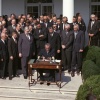A Review of For God and Profit: How Banking and Finance Can Serve the Common Good (Crossroad, 2016).
The Jesuits control the Federal Reserve. This conspiratorial New York subway graffito is perhaps a small sign that the church’s relationship to financial markets remains misunderstood. Financial judgment and moral judgment are different, but not unrelated, skills. Both must be learned and disciplined. Graham and Dodd managed 770 pages on security analysis, yet Aquinas left an unfinished summa with more than 3000 pages. A financial professional spends years learning markets, analyzing businesses and pricing risk. He learns to separate signals from noise, correlation from coincidence. He takes seriously St. Paul’s counsel to “test everything; hold on to what is good” (1 Thessalonians 5:21). In a profession based in computer screens filled with financial abstractions, it is easy to see how one could succumb to paralyzing ennui or limitless greed. To help professionals, public officials, church leaders and the faithful assess decisions made in the financial markets, Samuel Gregg offers a lucid and comprehensive guide to the church’s intellectual history in financial thought. For God and Profit is also an accessible review of contemporary themes in public finance and an insightful reflection on the vocation of finance.
In his previous books, Tea Party Catholic and Becoming Europe, Gregg proved himself to be a talented economic and political historian and analyst. In For God and Profit, he has more room to chart the church’s early history in financial matters, from premodern usury prohibitions to the medieval depositaries run by the Knights Hospitallers. Instead of tediously tracking theological skirmishes, Gregg guides the reader through the church’s developing understanding of concepts essential to modern finance and economics: private property, the time value of money, opportunity cost and the priceinformation system.
Gently yet firmly reminding senior churchmen and members of the faithful to gain sufficient knowledge before rendering moral judgment, Gregg challenges several misconceptions about finance. For example, though recent popes have denounced speculators, Gregg reminds us that risk-taking and price-setting are essential to the prosperity generated by free-market exchanges, and the scapegoating of middlemen is a technique often used by government officials to distract from their own failures. After patiently explaining routine yet popularly misunderstood market operations like short selling, Gregg recalls the humble and prudent words of Pope Benedict XVI: “If we do not deal competently with the matter, it will not be credible.”
A generous writer, Gregg introduces several important thinkers, including many who will be new to nonspecialists. With apologies to the tinfoil-hat crowd, the Jesuits do not control the Federal Reserve. But the Scholastic Jesuit Juan de Mariana is perhaps deserving of the title “The Proto- Volcker” for his evergreen insights in A Treatise on the Alteration of Money. Considering the case for stable money, Gregg observes that Mariana “saw currency debasement as something that benefited the government at the people’s expense.” Mariana drew an analogy to the role of standard weights and measures in merchant activity. No isolated theoretician, Mariana witnessed the financial collapse of his home country Spain in five official state bankruptcies from 1557 to 1607. For Mariana, refusing to debase the coin of the realm while instead reducing royal spending (tighter fiscal policy) was not vicious austerity but a just response to economic reality.
A perceptive observer of contemporary policy debates, Gregg notices a trace of false nostalgia in the public discourse on financial regulation. Gregg does not dispute that financial regulation can be necessary and just. But it is worth considering that oft-decried financial deregulation enabled plummeting costs to access investment opportunities of increasing quality for even the smallest investors. In 1980, the average stock mutual fund had an expense ratio over 2 percent, usually with an additional upfront fee of 8 percent and required a nontrivial minimum amount to invest. Today, an individual investor can invest a minimum of about $50 in a broad stock market index fund (ETF) for only 0.03 percent in expenses with zero upfront or transaction costs. Consumer finance startups are challenging traditional banks and pushing costs down for student loans, money transfers, investment advice and other retail finance products. Reflecting on the rapid pace of innovation and specialization in the industry, Gregg urges patience and humility to those tempted to make quick and broad moral pronouncements.
In modern times, the church’s moral reflection on finance has been underdeveloped. Beyond generic spiritual counsel against greed, Gregg notices very few substantial Christian treatments of the topic from the 17th century until the mid-20th century. Yet the industry continued to absorb a greater share of the workforce, especially young university graduates in recent decades. So how does a Christian respond to the banker at the bar in Whit Stillman’s Metropolitan who shares his existential dilemma with two young preppies:
I’ve got a good job that pays decently. It’s just that it’s all so … mediocre, so unimpressive. The acid test is whether you take any pleasure in responding to the question, “What do you do?” I can’t bear it.
For a response, Gregg directs us to Pope Pius XII’s remarks in 1950 on finance’s important contributions to the common good. The pope saw capital markets professionals providing a social function by helping to make money “fruitful” instead of “dissipating it, or leaving it to sleep without any profit.” Expanding on the biblical injunction to “be fruitful and multiply” in Genesis, Pius XII counsels financial professionals “to facilitate and encourage savings; to preserve savings for the future, at the same time rendering them productive in the present; to enable savings to share in useful enterprises which could not be launched without them …” Michael Sean Winters at the National Catholic Reporter notes that a spirit of “encounter” is an important theme for Pope Francis, yet it is also the essential spirit of the financial vocation. The finance professional must truly go forth to the peripheries of human creativity to help bring to market new means of human flourishing. This is powerfully expressed in Pius XII’s inspirational words to financiers in 1951: “You mark the crossroads where capital, ideas and labor encounter each other."
To end at the beginning, in offering the book’s introduction, Cardinal George Pell demonstrates a high level of interest and insight into matters of finance. It is worth further reflection by readers that the Jesuit pope from Argentina has bound much of the success of his papacy to the financial reform efforts led by the Australian cardinal. Left unaddressed by Gregg is the church’s own financial management. What principles should govern the church’s stewardship of its resources? How should the church allocate scarce resources and measure the results of these decisions? What standards of reporting and transparency should the church voluntarily offer the faithful? For thoughtful responses to these questions, the church might look to the author and to those who have carefully considered the ideas in For God and Profit.
Stephen Schmalhofer writes from New York City, where he works in technology and venture capital. He is a graduate of Yale University.










